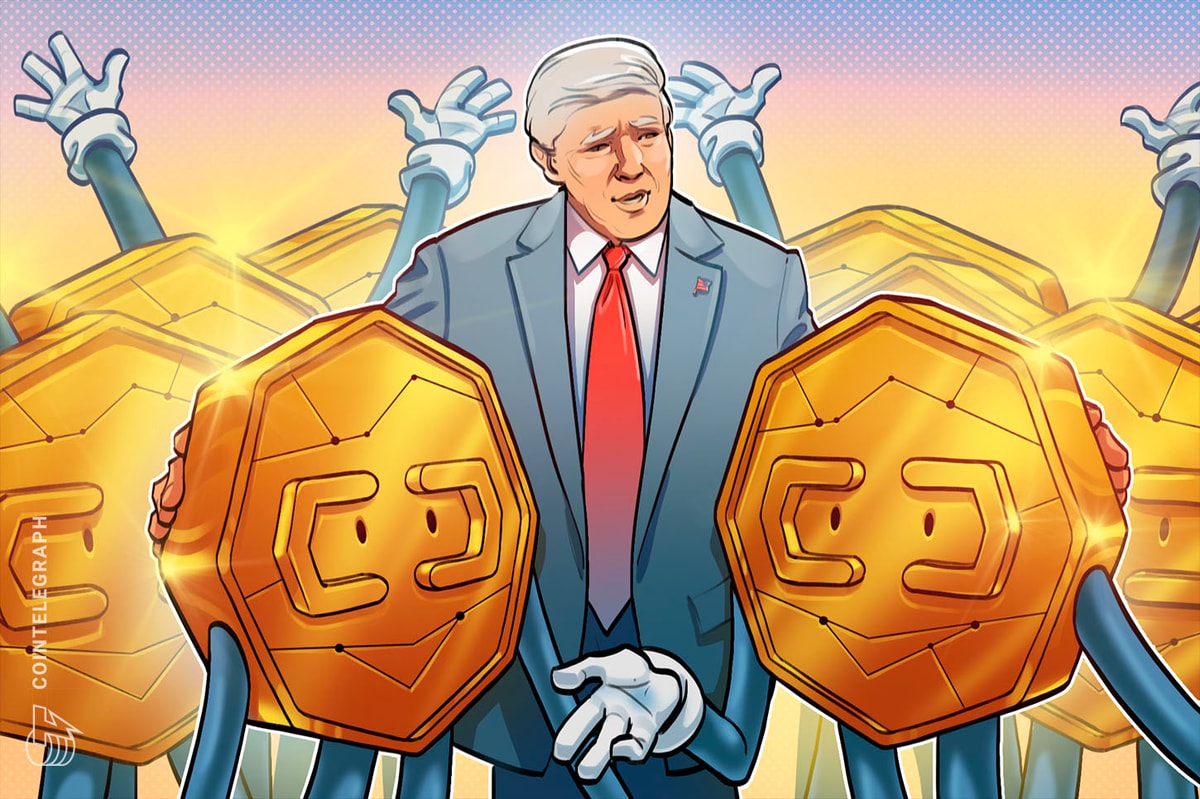It has been a blazing start to a new decade, with 13% more large, uncontrolled wildfires around the world this year compared with 2019. This has spelled dire consequences for CO2 levels, which have made worse a terrible COVID-19 pandemic that has led to unprecedented worldwide lockdowns that have rapidly pushed the economy toward digitization.
Related: How has the COVID-19 pandemic affected the crypto space? Experts answer
As a result of the COVID-19 pandemic, governments around the world have been forced to focus on integrating blockchain technology into their financial services. At the 75th anniversary of the United Nations General Assembly, Sky Guo, a founding member of the Official Monetary and Financial Institutions Forum and co-founder of Cypherium — an enterprise-focused platform facilitating interoperability between blockchains and central bank digital currencies, or CBDCs — discussed how the next generation of foreign policy leaders can leverage emerging digital technologies to solve the world’s most pressing challenges, given that 80% of world central banks are evaluating adopting CBDCs.
Related: Not like before: Digital currencies debut amid COVID-19
Switching to CBCDs and a world financial infrastructure that heavily relies on blockchain technology can nevertheless have a formidable impact on CO2 levels all over the world if the electricity used for energy is produced from coal or other fossil fuels that cause the highest levels of CO2 and other greenhouse gas pollution.
Related: The need to report carbon emissions amid the coronavirus pandemic
According to the study “The Carbon Footprint of Bitcoin,” conducted by researchers from the Technical University of Munich and MIT, Bitcoin (BTC) mining alone generates between 23.6 and 28.8 megatons in CO2 emissions each year, which contributes to climate change. The world’s CO2 levels hit new highs last year, a trend that is expected to repeat itself in 2020 despite coronavirus-related lockdowns that have forced a global industrial slowdown, according to a recent report published by the World Meteorological Organization.
In the time of the global pandemic, the economy will continue to digitize. So, the best way to avoid climate change is by adopting a climate policy that limits emissions and puts a price on them, according to the Environmental Defense Fund.
Carbon credits and markets are frequently incorporated into national and international efforts to mitigate increased concentrations of greenhouse gases in the atmosphere by putting a price on them. Experts often debate the pros and cons:
- A carbon tax directly establishes a price on greenhouse gas emissions, so companies are charged fees that accumulate for every ton of emissions they produce.
- A cap-and-trade/energy-trading system issues a set number of emissions “allowances” each year that can be auctioned to the highest bidder as well as traded on secondary markets, thereby creating a carbon price.
Blockchain technology can be used to track carbon credits — a generic term for any tradable certificate or permit representing the right to emit one ton of CO2 — to reduce environmental pollution and carbon emissions, according to the report “Blockchain of Carbon Trading for UN Sustainable Development Goals.”
World’s first tradable carbon token
The Universal Protocol Alliance, a coalition of leading blockchain companies and crypto firms, launched the world’s first tradable carbon token on a public blockchain, dubbed Universal Carbon (UPCO2). It can be bought and held as an investment or burned to offset an individual’s carbon footprint. Each token represents one year-ton of CO2 emissions that have been prevented by a certified REDD+ project preventing rainforest loss or degradation. It is backed by a Voluntary Carbon Unit, a digital certificate issued by Verra — an international standards agency — that enables projects to turn their greenhouse gas reductions into carbon credits that can be traded.
As Juan Pablo Thieriot, co-founder of the UPA and CEO of Uphold, explained:
“This year may go down as the key inflection point for climate change. The year it went from a far-off issue enshrined in distant accords like Kyoto and Paris, to an existential threat affecting the lives of tens of millions of people. In recent months, we’ve seen Australia and California on fire, ever more powerful hurricanes, the U.S. president-elect Joe Biden announcing a Climate Administration, and companies such as Apple, Microsoft, and Nike voluntarily committing to carbon neutrality.”
He also added that “Combating climate change is likely to become the dominant economic issue of the next 20 years.”
The UPCO2 token could lead to the establishment of a global clearing price for tokenized carbon credits by allowing market mechanisms to drive industrial and commercial processes in the direction of low emissions or less carbon-intensive approaches, as the supply of carbon credits in 2020 has only represented 22% of global greenhouse gas emissions, according to the World Bank.
Cap-and-trade programs of the top six CO2-emitting countries/regions of the world
Cap-and-trade programs use market forces to reduce emissions cost-effectively. This stands in contrast to “command-and-control” approaches where the government determines performance standards or technology choices for individual facilities. It also differs from a carbon tax in that it provides a high level of certainty about future emissions but not about the price of those emissions (carbon taxes do the inverse).
With cap-and-trade programs, the market determines a price on carbon, which drives investment and market innovation. It is the preferable policy when a jurisdiction has a specified emissions target, such as set by the Paris Agreement. There are a number of studies that have reviewed the success of cap-and-trade programs by identifying some key issues from the top six CO2-emitting countries/regions in the world.
China
China launched the initial phase of a national carbon market in 2017 with help from the Environmental Defence Fund to limit and reduce CO2 emissions from factories and other industries in a cost-effective manner. This year, China’s Ministry of Ecology and Environment moved closer to completing the launch of the market, releasing draft rules — in addition to registry and settlement regulations — for its national energy trading system.
The emissions trading scheme, or ETS, will initially cover coal- and gas-fired power plants.
Based on the plant’s power generation output, it will allocate allowances, or permits, and each fuel and technology will have different benchmarks. The ETS is expected to be the world’s largest and expand to seven additional sectors, covering one-seventh of worldwide CO2 emissions from fossil fuels. A report by the International Energy Agency dubbed “China’s Emissions Trading Scheme: Designing efficient allowance allocation” makes policy recommendations for China’s ETS.
Related: How the biggest CO2 polluter is becoming the world’s leading producer of solar panels
United States
Efforts in the United States to create a nationwide cap-and-trade system in 2009 proved unsuccessful. Instead, 10 states now participate in the Regional Greenhouse Gas Initiative, a cap-and-trade program established in 2009, while California has operated a cap-and-trade program since 2013 that is linked with a program in Quebec, Canada.
A study published by the Harvard Project on Climate Agreements dubbed “Carbon Taxes vs. Cap and Trade: Theory and Practice” argues that an economywide carbon pricing system is essential for any U.S. national policy that seeks to achieve meaningful, cost-effective reductions in CO2 emissions. Another study by the World Resources Institute titled “Putting a Price on Carbon: Reducing Emissions” finds that a well-designed carbon tax or cap-and-trade program could be the centerpiece of U.S. efforts to reduce greenhouse gas emissions.
Related: Is US environmental tax policy hindering solar power to fuel digital technologies?
European Union
The European Union has the world’s first, and its largest, major carbon market. Its ETS is at the core of its policy for fighting climate change, and it is one of the most important tools at its disposal for the cost-effective reduction of greenhouse gas emissions.
A study titled “Personal carbon trading: a review of research evidence and real-world experience of a radical idea” points out that personal carbon trading, a catch-all term for multiple downstream cap-and-trade policies, is an innovative CO2 mitigation approach. It seeks to limit a society’s carbon emissions by engaging individuals in the process, and it is able to cover over 40% of national carbon emissions by combining various mechanisms to drive socioeconomic and psychological behavioral change.
Another study dubbed “The European Union Emissions Trading System reduced CO2 emissions despite low prices” points out that the prices produced by carbon markets are often considered too low relative to the social cost associated with carbon, but nevertheless, the EU’s ETS resulted in a 3.8% reduction of total EU-wide emissions.
Related: Green policy and crypto energy consumption in the EU
India
In 2019, the Indian state of Gujarat launched the first-ever emissions trading system for particulate pollution. It serves as a pilot for the rest of India, as well as the world, and a means of reducing air pollution and facilitating economic growth. Additionally, leading companies in India set up their own carbon pricing mechanisms in a three-phase process. India’s emissions trading systems were reviewed in a report prepared by the Environment Defence Fund titled “India: An Emissions Trading Case Study.”
Related: India is fostering a solarized digital future
Russia
Currently, there is no cap-and-trade carbon pricing mechanism in Russia. A study dubbed “Carbon Tax or Cap-and-Trade for Russia? Evidence from RICE Model and Other Considerations” states that Russia should select a carbon tax over a cap-and-trade system due to political, economic and historical factors, but it concludes that Russia is unlikely to take decisive action to tackle climate change in the near future.
Related: Russia leads multinational stablecoin initiative
Japan
Japan has had a cap-and-trade program in place for Tokyo since 2010. A study titled “The impact of the Tokyo emissions trading scheme (ETS) on office buildings: what factor contributed to the emission reduction?” evaluates Tokyo’s ETS, which was the first emissions trading program for greenhouse gas emissions from office buildings.
While the government of Tokyo called the ETS successful, not everyone believes that it was the driving force behind the nation’s emission reductions. Some have argued that it was actually due to the Great East Japan Earthquake in 2011, which resulted in increased electricity prices. In the aforementioned study, researchers conducted an econometric analysis using a facility-level data set for Japanese office buildings, finding that half of the emission reduction resulted from the ETS, while the other half was a result of the electricity price increases.
Related: Japan to solarize its burgeoning digital economy
Conclusion
As Patricia Espinosa, executive secretary of the United Nations Framework Convention on Climate Change, pointed out: “COVID-19 hasn’t put climate change on hold.”
And as Alexandre Gellert Paris of the UNFCCC explained:
“As countries, regions, cities and businesses work to rapidly implement the Paris Climate Change Agreement, they need to make use of all innovative and cutting-edge technologies available. Blockchain could contribute to greater stakeholder involvement, transparency and engagement and help bring trust and further innovative solutions in the fight against climate change, leading to enhanced climate actions.”
The views, thoughts and opinions expressed here are the author’s alone and do not necessarily reflect or represent the views and opinions of Cointelegraph.The views and opinions expressed here are solely those of the author and do not necessarily reflect the views of Cointelegraph.com. Every investment and trading move involves risk, you should conduct your own research when making a decision.










